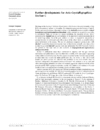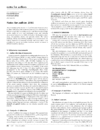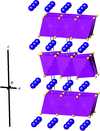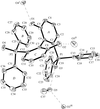issue contents
January 2003 issue

Cover illustration: Hydrogen-bond formation in the crystal structure of dichlorobis(DL-proline-![[kappa]](/logos/entities/kappa_rmgif.gif) O)zinc(II). The proline residues in the chain on the left-hand side have the R configuration, while those on the right-hand side have the S configuration. See Lutz & Bakker [Acta Cryst. (2003), C59, m18-m20].
O)zinc(II). The proline residues in the chain on the left-hand side have the R configuration, while those on the right-hand side have the S configuration. See Lutz & Bakker [Acta Cryst. (2003), C59, m18-m20].
editorial
Free 

international union of crystallography
Free 

inorganic compounds
Download citation


Download citation


In the title compound, the NiII cations have a pseudo-face-centered cubic cell, with cell parameter a  10.216 Å and tetrahedral cavities occupied by P atoms. The NiII cation has an octahedral coordination sphere consisting of six water O atoms. The planes of oppositely coordinated water molecules are in a cross conformation. The geometry of the hypophosphite anion is close to point symmetry mm2. The hypophosphite anions are hydrogen bonded to the coordinated water molecules.
10.216 Å and tetrahedral cavities occupied by P atoms. The NiII cation has an octahedral coordination sphere consisting of six water O atoms. The planes of oppositely coordinated water molecules are in a cross conformation. The geometry of the hypophosphite anion is close to point symmetry mm2. The hypophosphite anions are hydrogen bonded to the coordinated water molecules.
Download citation


Download citation


Single crystals of lithium niobium disulfide, prepared by separated reactant metathesis, yielded a refined Li content of y = 0.63 (6). The Li content has been further confirmed analytically both by flame photometry and by preliminary neutron powder diffraction data.
Download citation


Download citation


The structure of UO2(NO3)2(H2O)3 consists of two distinct centrosymmetric isolated hexagonal uranyl bipyramids, which share edges with two nitrate groups. Water is structurally located in the interstices between these isolated uranyl dinitrate clusters and at the equatorial edges of the [UO2(NO3)2] groups.
metal-organic compounds
Download citation


Download citation


Download citation


Download citation


Download citation


Download citation


Download citation


Download citation


Download citation


Download citation


Download citation


Download citation


Download citation


Download citation


Download citation


Download citation


Download citation


Download citation


Download citation


Download citation


Download citation


Download citation


organic compounds
Download citation


Download citation


Download citation


Download citation


Download citation


Download citation


Download citation


Download citation


Download citation


Download citation


Download citation


Download citation


Download citation


Download citation


Download citation


Download citation


Download citation


Download citation


Download citation


Download citation


Download citation


Download citation


Download citation


Download citation


Download citation


Download citation


Download citation


Download citation


Download citation


Download citation


Download citation


Download citation


Download citation


Download citation




 journal menu
journal menu


















































